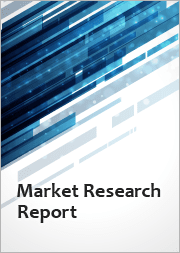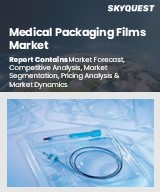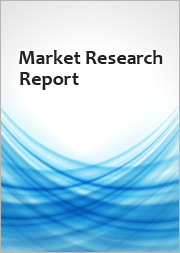
|
시장보고서
상품코드
1775380
의료용 포장 필름 시장 : 예측(2025-2030년)Medical Packaging Films Market - Forecasts from 2025 to 2030 |
||||||
의료용 포장 필름 시장은 CAGR 6.60%로, 2025년 85억 4,400만 달러에서 2030년에는 117억 6,300만 달러로 성장할 것으로 예측됩니다.
의료용 포장 필름 시장은 생명공학 기반 주사제에 대한 수요 증가와 의료 및 제약 분야의 확대로 인해 강력한 성장세를 보이고 있습니다. 이러한 의약품은 열에 취약한 경우가 많아 고열 말단 안정화 공정에 의존하지 않고도 제품 보호, 품질, 변조 방지, 환자 안전을 보장하는 포장 솔루션이 필요합니다. 의료용 포장 필름은 이러한 요구에 부응하여 의약품 포장을 위한 신뢰할 수 있고 효율적인 솔루션을 제공하는 데 중요한 역할을 하고 있습니다.
시장 성장 촉진요인
- 정부 구상과 의료 투자
첨단 의료 시스템에 대한 정부 투자는 의료용 포장 필름 시장의 주요 촉진요인입니다. 예를 들어 한국에서는 의료비의 절반 이상을 국가와 주정부가 부담하고 있으며, 국민건강보험(NHI)이 인구의 약 96%, 총 의료비의 절반 가까이를 커버하고 있습니다. 이로 인해 의료 및 서비스 이용의 편의성과 접근성이 향상되어 의료 포장 솔루션에 대한 수요가 증가하고 있습니다. 마찬가지로 호주의 경우, 2024년 의료비 지출은 전년 대비 6% 증가한 1,810억 달러에 달할 것으로 예상되며, 이 중 3분의 2 이상이 연방 및 주 정부에 의해 지원될 것으로 예상되며, Medicare Benefits Scheme(MBS) 및 Pharmaceutical Benefits Scheme((PBS)와 같은 프로그램은 1차의료에 보조금을 지급하고, 의료기기 및 포장에 대한 민간 투자를 유치하고 있습니다. 이러한 정책은 첨단 포장 솔루션의 혁신과 채택을 촉진하여 향후 5년간 시장 성장을 가속할 것으로 예측됩니다.
시장 세분화
- 폴리프로필렌의 장점
폴리프로필렌(PP)은 환경 친화적인 특성과 우수한 방습성으로 인해 의약품 포장 산업에서 큰 지지를 받고 있으며, 상당한 시장 점유율을 차지하고 있습니다. 폴리염화비닐(PVC)의 소각이 법적으로 제한되어 있는 유럽과 같은 지역에서는 폴리염화비닐(PVC)을 대체하고 있으며, PP의 블리스터 포장에 대한 적합성은 견고한 방습성을 제공하므로 제약 용도에서 PP의 채택을 촉진하고 있습니다. 예를 들어 러시아의 주요 기업인 SIBUR은 제약 분야의 블리스터 포장에 맞게 조정된 Millad NX 8000을 통합한 새로운 PP 기반 포장 솔루션을 발표했으며, PP에 대한 지속적인 투자로 시장에서의 우위를 더욱 강화할 것으로 예측됩니다.
지역 성장: 아시아태평양이 주도
아시아태평양은 의료용 포장 필름 시장의 주요 성장 동력이며, 건강에 대한 인식이 높아지고 민관 모두에서 많은 투자가 이루어지고 있습니다. 이 지역에는 세계 최대 규모의 의약품 포장 기업이 있으며, 풍부한 원자재와 낮은 생산 비용의 이점을 누리고 있습니다.
이 보고서의 주요 장점
- 인사이트 분석 : 고객 부문, 정부 정책 및 사회경제적 요인, 소비자 선호도, 산업별, 기타 하위 부문에 초점을 맞추고 주요 지역뿐만 아니라 신흥 지역까지 포괄하는 상세한 시장 인사이트를 얻을 수 있습니다.
- 경쟁 구도: 세계 주요 기업이 채택하고 있는 전략적 전략을 이해하고, 적절한 전략을 통한 시장 침투 가능성을 파악할 수 있습니다.
- 시장 성장 촉진요인과 미래 동향 : 역동적인 요인과 매우 중요한 시장 동향, 그리고 이들이 향후 시장 발전을 어떻게 형성할 것인지에 대해 알아봅니다.
- 실행 가능한 제안: 역동적인 환경 속에서 새로운 비즈니스 스트림과 매출을 발굴하기 위한 전략적 의사결정에 인사이트를 활용합니다.
- 다양한 사용자에 대응: 스타트업, 연구기관, 컨설턴트, 중소기업, 대기업에 유익하고 비용 효율적입니다.
어떤 용도로 사용되는가?
산업 및 시장 인사이트, 사업 기회 평가, 제품 수요 예측, 시장 진출 전략, 지역적 확장, 설비 투자 결정, 규제 프레임워크와 영향, 신제품 개발, 경쟁의 영향
분석 범위
- 과거 데이터(2022-2024년) 및 예측 데이터(2025-2030년)
- 성장 기회, 과제, 공급망 전망, 규제 프레임워크, 고객 행동, 동향 분석
- 경쟁사 포지셔닝, 전략 및 시장 점유율 분석
- 매출 성장률 및 예측 분석 : 부문별/지역별(국가별)
- 기업 프로파일링(전략, 제품, 재무정보, 주요 동향 등)
목차
제1장 개요
제2장 시장 스냅숏
- 시장 개요
- 시장의 정의
- 분석 범위
- 시장 세분화
제3장 비즈니스 상황
- 시장 성장 촉진요인
- 시장 성장 억제요인
- 시장 기회
- Porter's Five Forces 분석
- 업계 밸류체인 분석
- 규제 프레임워크
- 전략적 제안
제4장 기술 전망
제5장 세계의 의료용 포장 필름 시장 : 재료별
- 서론
- 폴리프로필렌(PP)
- 폴리에틸렌(PE)
- 폴리아미드(PA)
- 생분해성/바이오 기반 필름(예 : PLA, PHA)
- 기타
제6장 세계의 의료용 포장 필름 시장 : 필름 유형별
- 서론
- 열성형 필름
- 고배리어 필름
- 멸균 배리어 필름
- 기타
제7장 세계의 의료용 포장 필름 시장 : 용도별
- 서론
- 백
- 튜브
- 블리스터 팩
- 파우치·리딩 필름
- 기타
제8장 세계의 의료용 포장 필름 시장 : 최종사용자별
- 서론
- 제약회사
- 의료기기 제조업체
- 병원·진료소
제9장 세계의 의료용 포장 필름 시장 : 지역별
- 서론
- 북미
- 미국
- 캐나다
- 멕시코
- 남미
- 브라질
- 아르헨티나
- 기타
- 유럽
- 독일
- 프랑스
- 영국
- 스페인
- 기타
- 중동 및 아프리카
- 사우디아라비아
- 아랍에미리트
- 기타
- 아시아태평양
- 중국
- 인도
- 일본
- 한국
- 인도네시아
- 태국
- 기타
제10장 경쟁 구도
- 주요 기업과 전략 분석
- 시장 점유율 분석
- 기업인수합병(M&A)·합의·협업
- 경쟁 대시보드
제11장 기업 개요
- Amcor plc
- DuPont de Nemours, Inc.
- Berry Global Group, Inc.
- 3M Company
- Honeywell International LLC
- Wipak Oy
- Renolit SE
- Weigao Group
- Covestro AG
- POLYCINE GmbH
- Sealed Air Corporation
제12장 부록
- 통화
- 전제조건
- 기준연도와 예측연도 타임라인
- 이해관계자에 대한 주요 이점
- 분석 방법
- 약어
The Medical Packaging Films Market is expected to grow from USD 8.544 billion in 2025 to USD 11.763 billion in 2030, at a CAGR of 6.60%.
The medical packaging films market is experiencing robust growth, driven by the increasing demand for biotechnology-based injectable drugs and expanding healthcare and pharmaceutical sectors. These drugs, often heat-sensitive, require packaging solutions that ensure product protection, quality, tamper-evidence, and patient safety without relying on high-heat terminal stabilization processes. Medical packaging films are critical in meeting these needs, offering reliable and efficient solutions for pharmaceutical packaging.
Market Growth Drivers
- Government Initiatives and Healthcare Investment
Government investments in advanced healthcare systems are a key driver of the medical packaging films market. In South Korea, for instance, over half of healthcare spending is funded by national and state governments, with the National Healthcare Insurance (NHI) covering approximately 96% of the population and nearly half of total healthcare costs. This enhances affordability and access to healthcare services, spurring demand for medical packaging solutions. Similarly, in Australia, healthcare spending reached $181 billion in 2024, a 6% increase from the previous year, with over two-thirds funded by federal and state governments. Programs like the Medicare Benefits Scheme (MBS) and Pharmaceutical Benefits Scheme (PBS) subsidize primary care and ensure affordability, attracting private investment in medical equipment and packaging. These policies are expected to drive market growth over the next five years by fostering innovation and adoption of advanced packaging solutions.
Market Segment Analysis
- Dominance of Polypropylene
Polypropylene (PP) is gaining significant traction in the pharmaceutical packaging industry, holding a substantial market share due to its eco-friendly properties and excellent moisture-barrier capabilities. It is increasingly replacing polyvinyl chloride (PVC) in regions like Europe, where legislation restricts PVC incineration. PP's suitability for blister packaging, which provides robust moisture protection, has fueled its adoption in pharmaceutical applications. For example, SIBUR, a leading Russian company, introduced new PP-based packaging solutions incorporating Millad NX 8000, tailored for blister packaging in the pharmaceutical sector. Continued investments in PP are expected to further bolster its dominance in the market.
Regional Growth: Asia Pacific Leading the Way
The Asia Pacific region is a major growth engine for the medical packaging films market, driven by rising health awareness and significant investments from both public and private sectors. The region hosts some of the world's largest pharmaceutical packaging companies, benefiting from abundant raw materials and low production costs.
Key Benefits of this Report:
- Insightful Analysis: Gain detailed market insights covering major as well as emerging geographical regions, focusing on customer segments, government policies and socio-economic factors, consumer preferences, industry verticals, and other sub-segments.
- Competitive Landscape: Understand the strategic maneuvers employed by key players globally to understand possible market penetration with the correct strategy.
- Market Drivers & Future Trends: Explore the dynamic factors and pivotal market trends and how they will shape future market developments.
- Actionable Recommendations: Utilize the insights to exercise strategic decisions to uncover new business streams and revenues in a dynamic environment.
- Caters to a Wide Audience: Beneficial and cost-effective for startups, research institutions, consultants, SMEs, and large enterprises.
What do businesses use our reports for?
Industry and Market Insights, Opportunity Assessment, Product Demand Forecasting, Market Entry Strategy, Geographical Expansion, Capital Investment Decisions, Regulatory Framework & Implications, New Product Development, Competitive Intelligence
Report Coverage:
- Historical data from 2022 to 2024 & forecast data from 2025 to 2030
- Growth Opportunities, Challenges, Supply Chain Outlook, Regulatory Framework, and Trend Analysis
- Competitive Positioning, Strategies, and Market Share Analysis
- Revenue Growth and Forecast Assessment of segments and regions including countries
- Company Profiling (Strategies, Products, Financial Information, and Key Developments among others.
Key Market Segmentation:
By Material
- Polypropylene (PP)
- Polyethene (PE)
- Polyamide (PA)
- Biodegradable/Bio-based Films (e.g., PLA, PHA)
- Others
By Film Type
- Thermoformable Films
- High Barrier Films
- Sterile Barriers films
- Others
By Application
- Bags
- Tubes
- Blister Packs
- Pouches & Lidding Films
- Others
By End-User
- Pharmaceutical Companies
- Medical Device Manufacturers
- Hospitals & Clinics
By Geography
- North America
- USA
- Canada
- Mexico
- South America
- Brazil
- Argentina
- Others
- Europe
- UK
- Germany
- France
- Spain
- Italy
- Others
- Middle East and Africa
- UAE
- Saudi Arabia
- Others
- Asia Pacific
- Japan
- China
- India
- South Korea
- Thailand
- Indonesia
- Taiwan
- Others
TABLE OF CONTENTS
1. EXECUTIVE SUMMARY
2. MARKET SNAPSHOT
- 2.1. Market Overview
- 2.2. Market Definition
- 2.3. Scope of the Study
- 2.4. Market Segmentation
3. BUSINESS LANDSCAPE
- 3.1. Market Drivers
- 3.2. Market Restraints
- 3.3. Market Opportunities
- 3.4. Porter's Five Forces Analysis
- 3.5. Industry Value Chain Analysis
- 3.6. Regulatory Framework
- 3.7. Strategic Recommendations
4. TECHNOLOGICAL OUTLOOK
5. GLOBAL MEDICAL PACKAGING FILMS MARKET BY MATERIAL
- 5.1. Introduction
- 5.2. Polypropylene (PP)
- 5.3. Polyethene (PE)
- 5.4. Polyamide (PA)
- 5.5. Biodegradable/Bio-based Films (e.g., PLA, PHA)
- 5.6. Others
6. GLOBAL MEDICAL PACKAGING FILMS MARKET BY FILM TYPE
- 6.1. Introduction
- 6.2. Thermoformable Films
- 6.3. High Barrier Films
- 6.4. Sterile Barriers Films
- 6.5. Others
7. GLOBAL MEDICAL PACKAGING FILMS MARKET BY APPLICATION
- 7.1. Introduction
- 7.2. Bags
- 7.3. Tubes
- 7.4. Blister Packs
- 7.5. Pouches & Lidding Films
- 7.6. Others
8. GLOBAL MEDICAL PACKAGING FILMS MARKET BY END-USER
- 8.1. Introduction
- 8.2. Pharmaceutical Companies
- 8.3. Medical Device Manufacturers
- 8.4. Hospitals & Clinics
9. GLOBAL MEDICAL PACKAGING FILMS MARKET BY GEOGRAPHY
- 9.1. Introduction
- 9.2. North America
- 9.2.1. USA
- 9.2.2. Canada
- 9.2.3. Mexico
- 9.3. South America
- 9.3.1. Brazil
- 9.3.2. Argentina
- 9.3.3. Others
- 9.4. Europe
- 9.4.1. Germany
- 9.4.2. France
- 9.4.3. United Kingdom
- 9.4.4. Spain
- 9.4.5. Others
- 9.5. Middle East and Africa
- 9.5.1. Saudi Arabia
- 9.5.2. UAE
- 9.5.3. Others
- 9.6. Asia Pacific
- 9.6.1. China
- 9.6.2. India
- 9.6.3. Japan
- 9.6.4. South Korea
- 9.6.5. Indonesia
- 9.6.6. Thailand
- 9.6.7. Others
10. COMPETITIVE LANDSCAPE
- 10.1. Major Players and Strategy Analysis
- 10.2. Market Share Analysis
- 10.3. Mergers, Acquisitions, Agreements, and Collaborations
- 10.4. Competitive Dashboard
11. COMPANY PROFILES
- 11.1. Amcor plc
- 11.2. DuPont de Nemours, Inc.
- 11.3. Berry Global Group, Inc.
- 11.4. 3M Company
- 11.5. Honeywell International LLC
- 11.6. Wipak Oy
- 11.7. Renolit SE
- 11.8. Weigao Group
- 11.9. Covestro AG
- 11.10. POLYCINE GmbH
- 11.11. Sealed Air Corporation
12. APPENDIX
- 12.1. Currency
- 12.2. Assumptions
- 12.3. Base and Forecast Years Timeline
- 12.4. Key Benefits for the Stakeholders
- 12.5. Research Methodology
- 12.6. Abbreviations



















